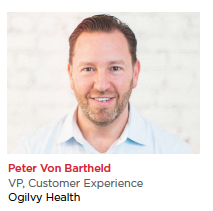 When it comes to supporting patients, the mantra is “put the patient first" or “put the patient at the center of the solution" — rightfully so. Successful marketers will always put the prime audience at the center of all programs, and in order to put the “patient first" or “at the center," it makes sense to know who the audience is and what appeals to them. Likewise, most marketers begin getting to know the audience and building programs following these similar steps:
When it comes to supporting patients, the mantra is “put the patient first" or “put the patient at the center of the solution" — rightfully so. Successful marketers will always put the prime audience at the center of all programs, and in order to put the “patient first" or “at the center," it makes sense to know who the audience is and what appeals to them. Likewise, most marketers begin getting to know the audience and building programs following these similar steps:
1. Understanding the business challenge
2. Defining the CRM objectives (ie, instilling patient confidence)
3. Defining the goals of CRM (ie, helping patients have the most positive treatment experience)
4. Undergoing a deep-dive discovery process to better inform the CRM program
This often includes assessing existing market research or leveraging social listening research and analytics to hear the topics being discussed
5. Scrutinizing the patient journey to identify known pain points
Pain points are often used as engagement opportunities that can help set the communication timing, frequency, and content development
6. Designing a KPI and measurement plan
Track patient performance to continue with initiatives that are working well, and make changes to those that are underperforming
While the above six points seem rote as the starting sequence for designing a patient program, the following message considerations are where the magic happens in truly mastering a differentiating program, patients will want to engage with for the long haul.
Messaging considerations that keep patients at the center of the program should consider these five main categories:
1. Overall patient journey: When planning messaging and content designed to satisfy the needs of the patient, it is essential to cover all stages of the journey
2. Type of information needed: Every patient’s situation is different. Some will desire details about clinical information, some will need to focus on financial assistance. Others will be interested in understanding key milestones or about side effects and how to manage them. Programs should cover all of these topics in small, easy to digest chunks.
3. Ongoing, real-time: Programs should be nimble and ready to keep patients up-to-date on news as it pertains to them. Be prepared to develop ad hoc messaging to cover breaking news and creating newsletters for brands with constant or regular updates.
4. Customer reviews: While every patient is unique, some will benefit by receiving inspirational messaging from other patients who are like them, while others will want to promote their success story. For the latter, it can be beneficial to offer the opportunity for patients to share their experience or become patient ambassadors.
5. Focus: Finally, this is the messaging consideration taking patient support programs by storm and proving to have the highest engagement by focusing on the patient’s overall needs.
Care for the entire person, and go “beyond the pill"
The most successful programs are those that care for and provide information about topics that benefit the whole person—weave in topics throughout programs such as caring for caregivers, nutrition, recipes, and exercise
Lacing these additional topics throughout communication gives patients something to look forward to receiving and reading from the brand other than information strictly about their drug, disease state, and therapy
Specifically select and present content to patients based on known, expected comorbidities or information detailed in the Patient Information (PI) or Important Safety Information (ISI)Keep patients in the limelight. Patients are happy to share what they want… Don’t be shy. Ask them, either during registration or weave it into a survey, patients will say what they are thinking and what their preferences are for information, or how they like to be communicated with. Don’t ask and don’t worry. Lists of consumers, who are patients, and have opted in to receive additional information about their disease state or potential therapy options can be purchased. These groups of people have already provided information about what they desire to learn.
Know what works and do more of it. Tagging articles and topics is an asset to understanding a patient’s information preferences. Even if they are not asked outright — their actions and behaviors (noting the articles they’ve engaged with) will inform what piques their interest. Using a central data repository allows programs to track of user preferences, providing the opportunity to deliver appropriate and meaningful information at the right time.
Sparking an “Ah-ha" Moment
Many patients want to play an active role in their therapy and are willing to share what they need if given the opportunity. Equally as important is sparking that “ah-ha" moment by producing an element of surprise (see messaging consideration 5) by giving them something that that will make them say, “I never thought of that — I’ll give it a try." When putting the patients first or at the center, consider joining them there and listening to what they have to say — it may be quite enlightening.(PV)
Ogilvy Health makes brands matter by keeping our audiences’ health, healthcare and wellness needs at the center of every touchpoint.
For more information, visit ogilvyhealth.com.


















